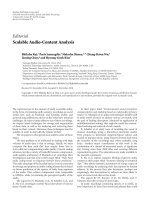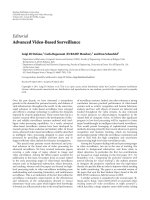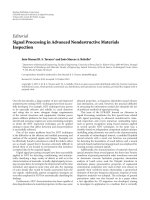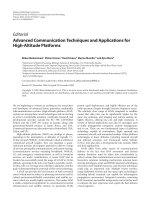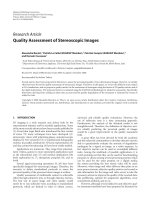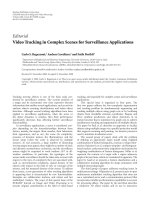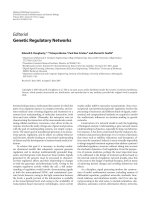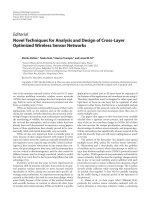Báo cáo hóa học: " Editorial Advanced Video-Based Surveillance" pot
Bạn đang xem bản rút gọn của tài liệu. Xem và tải ngay bản đầy đủ của tài liệu tại đây (429.35 KB, 2 trang )
Hindawi Publishing Corporation
EURASIP Journal on Image and Video Processing
Volume 2011, Article ID 857084, 2 pages
doi:10.1155/2011/857084
Editorial
Advanced Video-Based Surveillance
Luigi Di Stefano,
1
Carlo Regazzoni (EURASIP Member),
2
and Dan Schonfeld
3
1
Department of Electronics, Computer Science and Systems (DEIS), Faculty of Engineering, University of Bologna Viale
Risorgimento 2, 40136 Bologna, Italy
2
Department of Biophysical and Electronic Engineering, Faculty of Engineering, University of Genoa Via All’Opera Pia 11A,
16126 Genoa, Italy
3
Department of Electrical and Computer Engineering, University of Illinois at Chicago, Room 1020 SEO (M/C 154),
851 South Morgan Street, Chicago, IL 60607-7053, USA
Correspondence should be addressed to Luigi Di Stefano,
Received 9 March 2011; Accepted 9 March 2011
Copyright © 2011 Luigi Di Stefano et al. This is an open access article distributed under the Creative Commons Attribution
License, which permits unrestricted use, distribution, and reproduction in any medium, provided the original work is properly
cited.
Over the past decade, we have witnessed a tremendous
growth in the demand for personal security and defense of
vital infr astructure throughout the world. At the same time,
rapid advances in video-based surveillance have emerged
and offered a strategic technology to address the demands
imposed by security applications. These events have led to a
massive research effort devoted to the development of effec-
tive and reliable surveillance systems endowed with intel-
ligent video-processing capabilities. As a result, advanced
video-based surveillance systems have been developed by
research groups from academia and industry alike. In broad
terms, advanced v ideo-based surveillance could be described
as intelligent video processing designed to assist security
personnel by providing reliable real-time alerts and to
support efficient video analysis for forensics investigations.
This special issue presents recent theoretical and prac-
tical advances in the broad area of video processing for
advancedsurveillance.Wehavereceivednumerouspapers
covering a wide range of topics related to image and
video surveillance. Among the fifteen papers accepted for
publication in this issue, ten papers focus on issues related
to the early processing stages of video-based surveillance
systems such as background subtraction, object detection,
and tracking, whereas only five papers are focused on high-
level processing tasks in video surveillance including scene
understanding and reasoning, biometrics, and multicamera
surveillance. This is an indication of the fact that within the
surveillance community, improvement in the effectiveness
and robustness of the computations devoted to extract
elementary visual cues, upon which higher-level knowledge
is formed, are still perceived as key to the overall performance
of surveillance systems. Indeed, one often witnesses a strong
correlation between practical performance of video-based
systems such as activity recognition and human behaviour
analysis and how well objects of interest are detected and
tracked throughout the video streams. As also witnessed
by recent advances on object/category recognition in the
related field of computer vision, we believe that significant
progress in low-level processing will be required to foster
major breakthroughs in intelligent video-based surveillance.
This would permit leveraging of sophisticated reasoning
methods, drawing primarily from recent advances in pattern
recognition and machine learning, which are becoming
increasingly popular within the surveillance community and
used to deal with the high complexity and uncertainty
characterizing high-level video surveillance tasks.
Among the 10 papers dealing with early processing stages
in video surveillance, two are in the area of tracking, five
devoted to background subtraction, and three relate to
object detection. In particular, the first two contributions
are focused on visual tracking. In the first pap er (P. L. M.
Bouttefroy et al., “Integrating the projective transform with
particle filtering for visual tracking”), the authors propose
to integrate the projective transform into the importance
density of a particle filter in order to improve vehicle tracking
for traffic monitoring. The paper is an extended version of
the paper that won the Best Student Paper Award at the 6th
IEEE AVSS Conference, held in Genoa in 2009.
A s imilar scenario is considered in the second paper (K.
Quast and A. Kaup, “Auto GMM-SAMT: an automatic object
tracking system for video surveillance in trafficscenarios”),
which describes a shape adaptive mean-shift tracker relying
2 EURASIP Journal on Image and Video Processing
on Gaussian mixture models to adapt the kernel to the object
shape.
The subject of the second group of five papers is
devoted to background subtraction. The third paper (C.
Zhao et al., “Background subtraction via robust dictionary
learning”) relies on sparse representation and dictionary
learning to address the problem of reliable background
model estimation from a cluttered training sequence.
The fourth paper (Vikas Reddy et al., “Alowcomplexity
algorithm for static background estimation from cluttered
image sequences in surveillance contexts”) addresses the same
problem by describing a Markov random field framework
targeted at embedded applications.
Embedded surveillance systems are also the scope of the
fifth paper (A. Verdant et al., “Three novell analog-domain
algorithms for motion-detection in video surveillance”), which
focuses on power efficiency and proposes analog processing
techniques to perform motion detection at the sensor.
The sixth paper (M. R. Bales et al., “BigBackground-based
illumination compensation for surveillance video”) deals with
automatic i llumination compensation in order to minimize
false positives in foreground segmentation in the presence of
nuisances such as sudden changes of the lighting conditions
or camera parameters.
The seventh paper (R. H. Evangelio and T. Sikora, “Static
object detection based on a dual background model and a finite-
state machine”) presents an algorithm whereby background
estimation allows for detection of static (e.g., abandoned or
removed) objec ts in crowded scenes.
A third group of papers includes three contributions
addressing detection of objects of interest in surveillance
videos. The eighth paper (W. Louis and K. N. Plataniotis, Co-
occurrence of local binary patte rns (CoLBP) features for frontal
face detection in surveillance applications) proposes a novel
feature—referred to as co-occurrence of local binary patterns
(CoLBP)—to detect frontal faces.
The ninth paper (A. Gualdi et al., “Contextual infor-
mation and covariance descriptors for people surveillance: an
application for safety of construction workers”) demonstrates
the use of contextual information to improve the perfor-
mance of a pedestrian detector based on the LogitBoost
classifier. The paper then uses the detection system for
monitoring of a construction site to detect workers that do
not wear a hard hat.
The tenth paper (N. Fakhfakh et al., “3D objects localiza-
tion using fuzzy approach and hierarchical belief propagation:
application at level crossings”) introduces a robust stereo-
matching algorithm aimed at detection and localization of
obstacles in the 3D space and relies on the algorithm to
address the problem of visual monitoring at level crossings.
The five remaining papers in this special issue are concen-
trated on high-level processing in video-based surveillance
including three contributions in scene understanding and
reasoning, and each of the areas of biometrics and multicam-
era surveillance includes a single paper.
The next three contributions are focused on scene
understanding and reasoning. The eleventh paper (Y. Ben-
abbas et al., “Motion pattern ext raction and event detection
for automatic visual surveillance”) relies on extraction of
associated motion patterns from optical flow fields by means
of probabilistic clustering for automatic detection of events
related to crowds and groups of people.
In the twelfth paper (Z. L. Husz et al., “B ehavioural
analysis with movement cluster model for concurrent actions”),
the authors propose a method for recognition of complex
behaviors of a single individual by use of a movement
cluster model (MCM) that relies on sequences of human
pose parameters that can model global actions (e.g., full
body movement) as well as elementar y actions (e.g., arm
movement).
The thirteenth paper (N. M. Robertson and I. D. Reid,
“Automatic reasoning about causal events in surveillance
video”) introduces a rule-based reasoning process w hose aim
is to generate causal descriptions of mutual interactions
among people, for example, statements such as “person A
crossed the road in order to meet person B.”
The last two papers in the special issue deal with biomet-
rics for surveillance and multicamera systems, respectively.
In the fourteenth paper (S. Chen et al., “Face recognition
from still images to video sequences: a local facial feature based
framework”), the authors propose averaging multi-region
histogram features as the most promising technique to tackle
the challenging problem of face recognition in low-quality
CCTV videos.
The fifteenth and final paper in this issue (Y C. Xu et
al., “Camera network coverage improving by particle swarm
optimization”) presents a new method to improve the field of
viewcoverageofacameranetworkbyuseofaparticleswarm
optimization algorithm to efficiently determine the optimal
orientation of each camera.
We hope that the papers presented in this special issue
will serve as a catalyst for future developments in the exciting
and rapidly moving field of video-based surveillance systems.
Acknowlegments
We wish to thank all the authors for their submissions
and the reviewers for their invaluable and constructive
comments. We also wish to express our appreciation to
the administrative and publication staff of EURASIP for
their efforts during the preparation and review of the
papers. Finally, we wish to convey our deep gratitude to
the Editor-in-Chief of the EURASIP Journal on Image
and Video Processing, Professor Jean-Luc Dugelay, for his
encouragement and support of this special issue.
Luigi Di Stefano
Carlo Regazzoni
Dan Schonfeld
